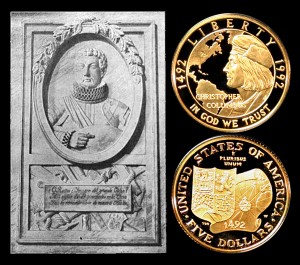Today, the Columbus Five-Dollar Gold Coin remembers the chains that bound him, his desire to be interred with them and the transport of his remains 220 years ago.
In his 1836 book, Lives of the Presidents of the United States, With Biographical Notices of the Signers of the Declaration of Independence; Sketches of the Most Remarkable Events in the History of the Country, from Its Discovery to the Present Time; and a General View of Its Present Condition, Robert W. Lincoln included commentary about Columbus:
=====
“Columbus could never forget the ignominy of his chains. He preserved the fetters, hung them up in his apartment, and ordered them to be buried in his grave.
“In compliance with his request, his body was removed from Seville to the island of St. Domingo, and deposited, with his chains, in a brass coffin, on the right of the high altar of the Cathedral of St. Domingo.
“There his bones remained, until the Spanish part of the island was ceded to France, in 1795.
“In consequence of this cession, the descendants of Columbus requested that his remains might be removed to Cuba.
“On the 19th of January, 1796, the brass coffin which contained the ashes of this great man, together with a chain which served as a memorial of his sovereign’s weakness, was carried down to the harbor in procession, under fire of the forts, and put on board a brig of war, to be removed to Havana.
“The brig arrived safely in the harbor of Havana, and the remains of the discoverer of America were buried with all the pomp and ceremony that could be bestowed upon them.”
=====
What were these chains that were so important they should be buried with the great explorer?
Cuba Illustrated, With the Biography and Portrait of Christopher Columbus, printed in 1893-94, J. C. Prince provided the background for the chains:
=====
Columbus suffered greatly because of so shameful conduct on the part of his companions. The very nobleness of his heart made him the natural protector of the persecuted. He punished the offenders severely, and without distinction.
Birth or position could not shield the culprit or prevent Columbus from exercising impartially the attributes of justice. This had for effect to exasperate the rapacious nobles and the cruel priests. They conspired together and resolved the ruin of Columbus by all possible means.
It was with this object in view that they secretly dispatched a vessel to Spain, with an emissary on board who had the mission of proffering before the King charges against Columbus.
Ferdinand, who had only as a last resort granted Columbus a twelfth of the royal rights upon the new domains, was rather well disposed to lend credence to the infamous charges made against his Vice-Roy.
He ordered a hidalgo by the name of Bobadilla — a man known for his unscrupulousness — to sail for the West Indies, with the special mission of bringing Columbus back to Europe.
This miserable instrument of a cowardly conspiracy accepted the mission with alacrity and discharged it with infamy.
Once in West Indies, he ordered the great navigator to be placed in irons, and had him conveyed to the ship like a common malefactor.
What a fall for a man who so recently had had the greatest honors bestowed upon him; what humiliation for so illustrious a personage to be treated so contemptuously at a sudden.
The thought that he was innocent and the victim of envy, and the consciousness of having discharged his duties with impartiality, sustained him in this great affliction.
The conduct of captain Andres Martin, to whom had been entrusted the command of the ship that brought Columbus back to Europe, was of great contrast with that of the miserable Bobadilla.
The moment he raised anchor in the port of Santo Domingo, he approached the noble prisoner with great respect, and asked him to give him his hands in order to free him from the chains that were cutting his flesh.
“I thank you for your offer, ” answered Columbus, “the King has sent me word in writing to submit to all the orders of Bobadilla. I will carry these chains until Ferdinand relieves me of them, and even until death if I should be called away sooner. They will bear testimony of Spain’s ingratitude, and of the manner she rewards the services of a man she recently raised so preeminently.”
When the vessel reached the port of Cadiz, Columbus was conveyed to the shore like a common criminal.
The indignation of the people, who held Columbus in great esteem, knew no bounds.
Every Spaniard, imbued with a sentiment of justice, felt for the noble man’s ill-treatment, and murmurs of anger could be heard against the Regent who had allowed the consummation of so shameful an action.
Universal discontent and the influence of the Queen, who had never ceased to befriend the illustrious Admiral, finally convinced Ferdinand that he had been guilty of a great injustice.
A letter of Columbus written to their Majesties, and in which he passed in review the accusations made against him, and where he exposed the malice and hatred of Bobadilla, dispelled all the doubts the Queen might have still entertained, and decided Ferdinand to immediately summon Columbus to Granada.
On his arrival, the Queen, with tears in her eyes, gave him her hand to kiss.
For the first time the great Admiral, worned and demoralized, lost his nerve and presence of mind. He fell, crying, at the feet of Queen Isabella, and allowed her to take off his chains.
…
=====
The Columbus Gold Five-Dollar Coin shows with an image of the tablet remembering the adventurer in the Cathedral of Havana.
